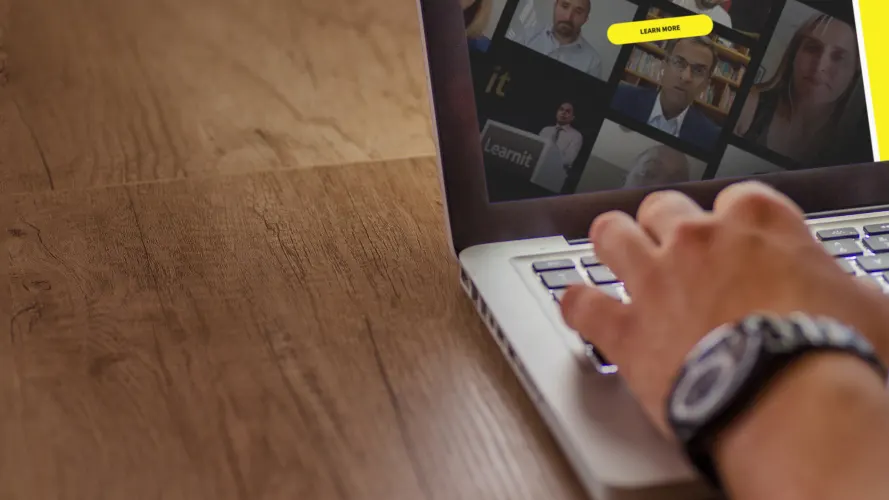
How To Pivot Your Conference Into A Media Company: Learnit Case Study
Savvy independent conference producers with postponed in-person gatherings until 2021 are now modernizing their websites to offer on-demand content with the help of Happily’s network of virtual event specialists.
By offering on-demand video content, organizers can experiment with new revenue models including advertising, sponsored virtual events, and subscription video on demand. Read on to learn how Learnit, a global education conference based in the UK, quickly launched an MVP of their new custom web platform in less than a month with the help of Happily’s digital community strategists and web developers.
Before Happily On Wordpress

After Happily With custom code

Step One
Custom or out of the box?
The first step is to decide whether or not a custom web platform is right for you. If you are planning to regularly host a variety of content on multiple platforms, then a custom website may be the right fit.
Learnit, for example, wanted their users’ data to be seamlessly transferred between their on-demand content platform to an external platform called Jublia, which specializes in scheduled networking meetings. Happily and Jublia’s web developers worked together to leverage Jublia’s matchmaking and scheduling API with Learnit’s expanded profile data.
In the end, owning your data allows you to create a single sign-on experience that reduces the friction for your user to convert into an action that takes place on other websites.
Step Two
Assemble your team
After committing to the process of re-building your site, it’s now time to assemble a team who can help you strategize around the new business opportunities, design the new version of the site, and put it to code.
For Learnit, we decided to go with an executive-level backend web developer and project manager with a senior level front end designer. While hourly rates may be higher on the executive levels, the time saved in reduced errors can be invaluable for projects with a tight turn-around time.
In the future, we can always save money later by reducing down to a lower level developer once the site is launched. Spending a little more upfront for expertise in the architecture stage though, can truly by invaluable.

Step Three
Build user personas and workflows
Now it’s time to begin to create user personas. This exercise greatly helps the entire team to built empathy for your users and get clarity on the experience design. It will also shine a light on assumptions about your user’s motivations and needs that should be tested before writing code.
In Learnit’s case, we spent two hours getting to understand the organization’s mission, objectives, and core revenue-generating products as well as mapping out the workflow for their two main user personas. This exercise helped us all to determine priorities for building the site and communicating the nuanced interactions that create a Learnit brand experience.
User personas and workflows are critical steps to the start of any new product feature and most definitely for the launch of a new website with your team!

Step Four
Create a sitemap
With a greater understanding for the desired user workflow, we can then layout a visual representation of how the pages on the website will come interact with each other. Like user personas, the sitemap is an essential part of helping everyone on the team know exactly what they’re building.
Moving too fast can get you into trouble sometimes. With a deadline of 10 business days to launch a fully rebuilt website, we made a sitemap only once at the proposal / scoping phase of the project and didn’t get a chance to update it during the sprint.
Lesson learned: a sitemap is truly a living document and, no matter what the time pressures may be, the small time it takes to maintain clean documentation as you go can save hours in confusion.

Step Five
Wireframe and code
Now, the fun part. Design and code! A wireframe is a document that shows where visual elements will go and code is a language by which you can tell the computer how you want it to function.
For the Learnit project timeline, we went straight to high fidelity wireframes presented through Invision so their team could give feedback on their own time. We worked through two different time zones (UK & LA/West Coast), so the ability to communicate asynchronously on designs this way was crucial.
Regular check-ins and good project management software are critical to rapidly iterating on websites during sprint.
Lastly
QA, QA, and release
With everything ready to go, it’s time to test and test again. And again if you need. Oftentimes we will spend more time in QA than we will in actually creating the website. Seeing your vision come to life can often visualize gaps in thinking from all members of the team.
For the Learnit project, we barely had enough time to test properly enough before their desired deadline of Friday morning so we delayed the re-launch announcement to Sunday.
The process often takes longer than you think, so make sure to pad the time and stay close to the updates to help steer the ship!
Interested in having Happily help you level up? Schedule A Call
More from the Happily Blog


